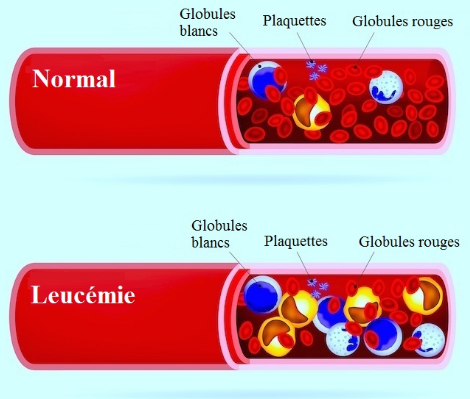A disease associated with poor prognosis, leukemia is now benefiting from advances in research: several treatment options are now available to patients. Acute myeloid leukemia, AML, is a pathology whose frequency increases, with a mean age of diagnosis around 65 years. What are the different types of leukemia, their manifestations, and what support is possible?
Definition
Leukemia (cancer of the blood) is a type of cancer characterized by uncontrolled proliferation in the bone marrow. of cells at the origin of white blood cells. The production of too many white blood cells by the body helps to weaken the immune system, they have no time to mature.
Recall :
White blood cells (also called leukocytes) intervene in the fight against infections, and play a vital role in the functioning of the immune system. Red blood cells transport oxygen in the blood. The bone marrow, a semi-liquid substance inside the bones, is the place of production of white and red blood cells, and platelets.
Types of leukemia
Chronic leukemias are characterized by the proliferation of cells that have been produced in the bone marrow, at an advanced stage of their differentiation into blood cells. They evolve over several years. There are two types of chronic leukemia, distinguished by the type of cells affected, chronic lymphoid leukaemias, the most common form and chronic myeloid leukemias, the most severe.
Acute leukaemias are characterized by the proliferation in the bone marrow of cells at a premature stage of their differentiation. Acute leukaemias are rapidly evolving, although their prognosis has improved significantly in recent years. There are two types of acute leukemia, distinguished by the type of cells affected, acute lymphoblastic leukaemias and acute myeloblastic leukemias.
causes
Leukemia does not have any causes identified so far. Several risk factors may nevertheless favor the occurrence of the disease, including family history, a genetic anomaly, genetic disorders (Dawn syndrome and Franconi's disease), exposure to high doses of radiation or benzene, side effects of chemotherapy.
sYMPTOMS
They can differ according to the type of leukemia but are observed most often one. fatigue, enlarged lymph nodes, fever, bouts of discomfort, weight loss, bone or joint pain, anemia, frequent infections, and unusual bleeding.
The symptoms of leukemia will vary depending on the category of leukemia encountered. In general, the clinical signs suggestive of leukemia are:
splenomegaly;
adenomegaly;
hepatomegaly.
The other signs depend on the more or less important involvement of the bone marrow and can be:
signs of anemia with pallor, fatigue, due to the decrease of red blood cells;
signs of thrombocytopenia, with haemorrhages, due to decreased platelets;
signs of leukopenia with infections.
The diagnosis is usually not made on clinical signs, but on abnormalities of the globules discovered by chance at the blood test.
Diagnostic
The diagnosis is made by performing a blood count, the NFS, showing by the type of leukemia a drop or increase in the number of white blood cells, a drop in red blood cells and platelets. An examination of the bone marrow, called a myelogram, confirms the diagnosis and the type of acute leukemia by analyzing the bone marrow cells collected during a sample taken under local anesthesia in the sternum or pelvic bone. . Molecular analysis of blood cells during a blood test also helps to advance the diagnosis.
Treatment
Treatment varies according to the type of leukemia:
For acute leukemias can be considered intensive chemotherapy, associated with blood transfusions, brain radiotherapy in some cases, a bone marrow transplant, antimitotic and corticosteroids (in the case of acute lymphoblastic leukemia in children) . The chances of successful treatment vary with the age and type of leukemia. The chances of recovery are 80% in children. The treatment of chronic lymphocytic leukemia differs according to the stage of evolution of the disease.
Simple monitoring is required in stage A and chemotherapy is required in stages B and C. A new class of drugs, monoclonal antibodies, is now used for patients who have failed chemotherapy.
In the case of chronic myeloid leukemia, Imatinib is most often prescribed. A bone marrow transplant is considered in case of resistance to Imatinib.

